| Dodge Charger (1966) | |
|---|---|
 1969 Dodge Charger R/T | |
| Overview | |
| Manufacturer | Dodge ( Chrysler) |
| Production | 1966–1978 |
| Body and chassis | |
| Class |
Mid-size Muscle car |
| Layout | FR layout |
| Platform | B-body |
| Chronology | |
| Successor | Dodge Magnum |
The Dodge Charger (1966), also known as Dodge Charger (B-body), is a mid-size automobile that was produced by Dodge from 1966 to 1978, and was based on the Chrysler B platform.
Origin

During the early 1960s, automakers were exploring new ideas in the personal luxury and specialty car segments. Chrysler, slow to enter the specialty car market, selected their Dodge Division to enter the marketplace with a mid-size B-bodied sporty car to fit between the " pony car" Ford Mustang and " personal luxury" Ford Thunderbird. [1] The intention was to create a fastback look while sharing as much existing company hardware as possible. [1] utilizing lessons learned from the luxury coupe Chrysler 300.
The Coronet-based Charger that resulted [2] was introduced in mid-season of the 1966 model year in response to the Rambler Marlin, Ford Mustang, and Plymouth Barracuda. The styling was generally a departure from the Dodge's mainstream cars. [3] The 1965 Marlin, along with the Charger that arrived during the 1966 model year, were two cars which set a new standard for radical fastback design in American mid-size automobiles. [4] According to Richard M. Langworth, "because it was an intermediate like the Rambler Marlin, the Charger could have been an aesthetic disaster, but long side windows prevented its sweeping roof from looking too heavy." [5]
Burt Bouwkamp, Chief Engineer for Dodge during the 1960s and one of the men behind the Charger, related his experience during a speech in July 2004.
Lynn Townsend was at odds with the Dodge Dealers and wanted to do something to please them. So in 1965 he asked me to come to his office - for the second time. He noted that one of the Dodge Dealer Council requests was for a Barracuda type vehicle. The overall dealer product recommendation theme was the same - we want what Plymouth has. The specific request for a Mustang type vehicle was not as controversial to Lynn. His direction to me was to give them a specialty car but he said 'for God's sake don't make it a derivative of the Barracuda': i.e. don't make it a Barracuda competitor.
So the 1966 Charger was born.
"We built a Charger 'idea' car which we displayed at auto shows in 1965 to stimulate market interest in the concept. It was the approved design but we told the press and auto show attendees that it was just an "idea" and that we would build it if they liked it. It was pre-ordained that they would like it." [6]
First generation
| First generation | |
|---|---|
 1966 Dodge Charger | |
| Overview | |
| Model years | 1966–1967 |
| Designer | Carl Cameron |
| Body and chassis | |
| Body style | 2-door fastback |
| Related |
Dodge Coronet Plymouth Belvedere Plymouth Satellite Plymouth GTX |
| Powertrain | |
| Engine | 318 cu in (5.2 L) 2bbl A
V8 (1966) 318 cu in (5.2 L) 2bbl LA V8 (1967) 361 cu in (5.9 L) 2bbl B V8 (1966) 383 cu in (6.3 L) 2bbl B V8 (1967) 383 cu in (6.3 L) 4bbl B V8 426 cu in (7.0 L) 2×4bbl Hemi RB V8 440 cu in (7.2 L) 4bbl RB V8 (1967) |
| Transmission | A230 3-speed
manual A833 4-speed manual TorqueFlite 3-speed automatic |
| Dimensions | |
| Wheelbase | 117.0 in (2,970 mm) |
| Length | 203.6 in (5,170 mm) |
| Width | 75.8 in (1,930 mm) |
1966
The Charger made its debut in mid-1966. Sharing its chassis and front-end sheet-metal with the mid-sized Coronet, the Charger was positioned to take on AMC's conceptually similar Rambler Marlin. [1] It was better looking, but somewhat more expensive, $2,850 to $3,100 ($26,764 in 2023 dollars [7]) to ($29,111 in 2023 dollars [7]). [8]
Significantly, the Charger's interior was different from all other cars, with a full-length center console and "all bucket seating" front and rear, inspired by the 1960-1962 Chrysler 300, and was similar to the 1964 Pontiac 2+2. The rear's pseudo-buckets could be folded down to create interior space accessible via the rear hatch. [9] The Charger was not intended to compete head-to-head in performancy with pony cars, but was available with Chrysler's famed 426 Hemi V8. [9]
On January 1, 1966, viewers of the Rose Bowl were first introduced to the new "Leader of the Dodge Rebellion", the 1966 Charger. The Charger's debut also followed by a half model year the introduction of a new street version of the 426 cu in (7.0 L) Chrysler Hemi engine. With the Charger, Dodge had a new model to build a performance image to go along with this engine.
Designed by Carl "CAM" Cameron, the Charger introduced a fastback roofline and pot-metal "electric shaver" grille, complete with fully rotating headlights, a feature not seen on a Chrysler product since the 1942 DeSoto. In the rear, the fastback design ended over a full-width six-lamp taillight with chromed "CHARGER" lettering.

Inside, the standard Charger featured a simulated wood-grain steering wheel, four individual bucket seats with a full-length console from front to rear. The rear seats and rear center armrest pad also folded forward while the trunk divider dropped back, which allowed for cargo room. [10] Numerous interior features were exclusive to the Charger including door panels, courtesy lights, as well as premium trim and vinyl upholstery. The instrument panel did not use regular bulbs to light the gauges, but rather electroluminescence lit the four chrome-ringed circular dash pods, needles, radio, shifter-position indicator in the console, as well as clock and air conditioning controls if equipped. The dash housed a 0 to 6000 rpm tachometer, a 0 to 150 mph (240 km/h) speedometer, as well as alternator, fuel, and temperature gauges as standard equipment. [10]
Engine selections consisted of only V8s. 1966 transmissions included a three-speed steering-column mounted manual with the base engine, a console mounted four-speed manual, or three-speed automatic. In 1966, four engines were offered: the base-model 318 cu in (5.2 L) 2-barrel, the 361 cu in (5.9 L) 2-barrel, the 383 cu in (6.3 L) 4-barrel, and the new 426 Street Hemi. Only 468 Chargers were built with the 426. [11]
Total production in 1966 came to 37,344 units for the mid-model year introduction.

In 1966, Dodge took the Charger into NASCAR in hopes that the fastback would make their car a winner on the high-banks. However, the car proved difficult to handle on the faster tracks because its body generated lift. Drivers would later claim that "it was like driving on ice." To solve this problem Dodge installed a small lip spoiler on the trunk lid that improved traction at speeds above 150 mph (240 km/h). This was made a dealer-installed option in late-1966 and in 1967, because of NASCAR rules, made the 1966 Charger the first U.S. production vehicle to offer a spoiler. (Small quarter panel extensions were added in 1967.) The addition of the spoiler helped David Pearson, driving the #6 Cotton Owens-prepared Dodge cars, to win the NASCAR Grand National championship in 1966 with 15 first-place finishes, though only one, the Capital City 300 in Richmond, VA, was achieved using the Charger. [12]
1967

The 1967 model year Charger received minor changes. Outside, new fender-mounted turn indicators were introduced [13] and these would serve as the main external identifiers between a 1966 and 1967 Charger.A vinyl roof became available. Inside, the full-length console was eliminated to satisfy customer complaints about the difficulty for entry and exit from the back seats. It was replaced with a regular-sized console. Bucket seats were standard, but a folding armrest/seat and steering column transmission shifter was an option allowing three people to sit in the front.
The 440 "Magnum" was added and the 361 cu in (5.9 L) V8 was replaced by a 383 cu in (6.3 L) engine. The 440 was rated at 375 bhp (280 kW) with a single 4-barrel carburetor. The 318 two-barrel "LA" Chrysler LA engine was now the base engine with wedge-shaped combustion chambers, unlike the previous 1966 polyspherical (or "poly") design, it was rated at 230 bhp (170 kW). The 383 4-barrel rated at 325 bhp (242 kW) and the 426 Street Hemi rated at 425 bhp (317 kW) remained as options. A total of 118 Chargers were built with the 426 engines in 1967, 58 cars were built with a four-speed transmission and 59 cars were built with the automatic transmission. The R/T package was also introduced in 1967.
Sales of the 1967 Chargers dropped to half of the previous introductory half-year with a total of 15,788 units. [14] According to automotive historian Patrick Foster, both the AMC Marlin and the very similar looking first generation Dodge Charger "flopped on the market as sporty car buyers were showing their preference for compact pony cars." [15]
Second generation
This section needs additional citations for
verification. (January 2014) |
| Second generation | |
|---|---|
 1969 Dodge Charger R/T | |
| Overview | |
| Model years | 1968–1970 |
| Assembly | United States:
Detroit, Michigan Hamtramck, Michigan Los Angeles, California St. Louis, Missouri |
| Designer | Harvey J. Winn, Richard Sias, Bill Brownlie, Diran Yazejian [16] |
| Body and chassis | |
| Body style | 2-door hardtop |
| Related |
Dodge Coronet Plymouth Belvedere Plymouth Satellite Plymouth GTX Plymouth Road Runner |
| Powertrain | |
| Engine | 225 cu in (3.7 L) 1bbl
I6 318 cu in (5.2 L) 2bbl LA V8 383 cu in (6.3 L) 2bbl B V8 383 cu in (6.3 L) 4bbl B V8 426 cu in (7.0 L) 2×4bbl Hemi V8 440 cu in (7.2 L) 4bbl RB V8 440 cu in (7.2 L) 2×3 RB (1970) |
| Transmission | A904 3-speed
automatic A727 3-speed automatic A230 3-speed manual A833 4-speed manual |
| Dimensions | |
| Wheelbase | 117 in (2.97 m) |
| Length | 208 in (5.28 m) (1968-69) 207.9 in (5.28 m) (1970) |
| Width | 76.7 in (1.95 m) (1968-69) 76.6 in (1.95 m) (1970) |
| Height | 53.2 in (1.35 m) (1968-69) 53.0 in (1.35 m) (1970) |
1968
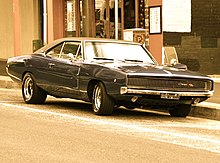
The entire B-body lineup for the 1968 model year was redesigned and the Charger was further differentiated from the Dodge Coronet models. Less upscale than the first generation, the new model featured coke bottle styling by Richard Sias, with curves around the front fenders and rear quarter panels. Front and rear end sheet metal was designed by Harvey J. Winn. The rear end featured a "kick up" spoiler appearance, inspired by Group 7 racing vehicles. The fastback roof was gone, in favor of a "flying buttress" similar to that of the 1966-67 Pontiac GTO. The Charger retained its full-width hidden headlight grille, but a vacuum-operated cover replaced the electric motor powered rotating headlights. The previous full-width taillights were replaced with dual circular units at the direction of Styling Vice President, Elwood P. Engel. Dual scallops were added to the doors and hood.
Inside, numerous "downscalings" were evident. A conventional fixed rear bench seat replaced the folding bucket seat design. The conventional trunk area included a vinyl mat, rather than the previous model's carpeted cargo area. The center console in the front remained, but there was no center armrest. The tachometer was now optional and the electroluminescent gauges were replaced with a conventional design.
Even the model's engine options ended up reduced midyear, when the standard 318 cu in (5.2 L) 2-bbl V8, was replaced with Chrysler's basic 225 cu in (3.7 L) slant-six. [17] The 383-2 and 383-4 remained unchanged.
R/T
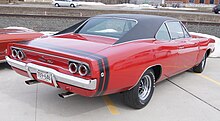
A new high-performance package was added, the R/T ("Road/Track", not to be confused with the Road & Track) magazine). The R/T came standard with the previous year's 440 "Magnum", with the 426 Hemi optional. With either, the Charger had evolved into possibly the top Chrysler-made muscle car. [9]
In 1968, Chrysler Corporation began a marketing campaign featuring a cartoon bee with an engine on its back promoting models called the "Scat Pack". The Coronet R/T, Super Bee, Dart GTS, and Charger R/T received bumble-bee stripes (of two thin stripes framing two thick ones). The stripes were standard on the R/Ts and came in red, white, or black, but could be deleted at no extra cost.

The 1968 film Bullitt helped popularize the Charger R/T for its notable car chase sequence alongside the titular character's 1968 Ford Mustang GT through the streets of San Francisco, which has been regarded as one of the most influential car chase scenes in movie history. In the film, a black Charger R/T 440 is chased by Steve McQueen's Ford Mustang GT, jumping on the San Francisco slopes. [18] [19] The 1968 model year Charger sales increased to 96,100, including over 17,000 Charger R/Ts.
1969

The 1969 model year brought few modifications. Exterior changes included a new grille with a center divider and new longitudinal taillights, both designed by Harvey J. Winn. A new trim line called the Special Edition (SE) was added. This could be available by itself or together with the R/T, thus making an R/T-SE. The SE added leather inserts to the front seats only, chrome rocker moldings, a wood grain steering wheel, and wood grain inserts on the instrument panel. A sunroof was added to the options list, but was ordered on only 260 Chargers. The bumblebee stripes returned, but were changed slightly. Instead of four stripes, it now consisted of a wide stripe framed by two smaller stripes. In the middle of the stripe, an R/T cutout was placed. If the stripe was deleted, a metal R/T emblem was placed where the R/T cutout was. Total production was around 89,199 units.

There were two different 383 engines available for the 1969 model year: 2-barrel and 4-barrel. The 2-barrel was rated at 290 hp. The four-barrel engine was rated at 330 hp and was identified on the air cleaner as "383 / FOUR BARREL". The 330-hp engine was unique to the Charger model in 1969. While this engine was available with an un-silenced air cleaner option, it differed internally from the 335-hp 383 "Magnum". Differences between the 330-hp 383 4-barrel and 335-hp 383 were mostly internal. Both versions used the Carter AVS carb and the larger exhaust manifolds from the 440 Magnum engines, but the Magnum had a windage tray in the oil pan, a different camshaft profile, and different valve springs. In 1969 the B-series engines were all painted Chrysler Engine Turquoise with the exception of the 4-barrel 383 four-speed and 440 Magnum engines which were painted Chrysler "High-Performance Orange". As usual, the 426 Hemi was painted "Street Hemi Orange". The 383 Magnum motor was used in Road Runners and Super Bees, but did not appear in a Charger body until 1971.
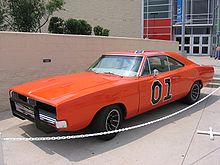
The television series The Dukes of Hazzard (1979–1985) featured an orange-painted 1969 Charger named The General Lee. "The General" sported the Confederate battle flag painted on the roof and the words "GENERAL LEE" over each door. The windows were always open, as the doors were supposedly welded shut for racing, and the actors would do a window slide to get in and out. The number "01" is painted on both doors. Also, when the horn button was pressed, it played the first 12 notes from the de facto Confederate States anthem " Dixie". The car performed spectacular jumps in almost every episode, and the show's popularity produced consumer interest in the car.
Charger 500
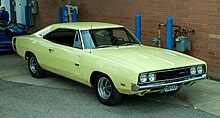
In 1968, the NASCAR inspired Charger R/T failed to beat the Ford cars (the Ford Torino Talladega and the Mercury Cyclone Spoiler II) on the high-banks oval-tracks. Wind tunnel tests showed the tunneled rear window caused lift and the gaping mouth induced drag. As a result, Dodge made the rear window flush with the rest of the roof and put a 1968 Coronet grille in the front.
The original Charger 500 prototype was a 1968 Charger R/T with a 426 Hemi and automatic transmission. The prototype was painted in B5 Blue with a white stripe, as well as a white interior. The Charger 500 was one of three models introduced in September 1968. The standard engine was the 440 Magnum, but factory literature described the 426 Hemi was standard. The Charger 500 had the Torqueflite standard and the same equipment standard as the R/T.
A total of 392 Charger 500s were made, of which only 67 had the 426 Hemi engine; 27 with a 4-speed and 40 with an automatic transmission.
Charger Daytona

Dodge was not satisfied with the results of the Charger 500. The car was not enough to beat the other aerocars on the NASCAR circuit. After months of research and development, including at the aftermarket shop, Creative Industries, the Charger Daytona was introduced on April 13, 1969. It quickly received over 1,000 orders.
Chrysler made many attempts at improving the aerodynamics of the 500 by adding noses rumored to be up to 23 in (580 mm) long. The Charger Daytona finally received an 18 in (460 mm) nose. The full-size Charger Daytona was tested with an 18 in (460 mm) nose at the Lockheed-Martin Georgia facility. The test was a success and the project was greenlighted. The nose piece was only part of the innovation. The Charger Daytona also received a 23 in (580 mm) tall wing in rear. This wing was bolted through the rear quarter panels and into the rear subframe. Although proven to be less effective than shorter wing designs, the engineer responsible for the development of the wing, John Pointer, chose the tall design so the wing would be in "clean air" to help increase the car's overall speed. That the tall wing prevents interference with the operation of the trunk lid can be considered a fortunate coincidence. [20] The tall wing also helped in an unintended way, by giving the car directional stability due to its deeply splinted sides.
The Charger Daytona engineering model was tested on the Chelsea, Michigan Chrysler Proving Grounds on July 20, 1969. Driven by Charlie Glotzbach and Buddy Baker, it was clocked at 205 mph (330 km/h) with a small 4-bbl. carb. The Charger Daytona's nose made 1,200 pounds of downforce and the wing made 600 pounds of downforce. The Dodge styling department wanted to make changes to the Charger Daytona as soon as they saw it, but was told by Bob McCurry to back off; he wanted function over finesse.
The Charger Daytona introduced to the public had a fiberglass nose without real headlamps and a wing without streamlined fairings. The media and public loved the car, but were mystified by the reverse scoops on the front fenders. The PR representatives claimed it was for tire clearance. Actually, they reduced drag by 3% by ventilating trapped air out of the wheel wells.
The Charger Daytona came standard with the 440 Magnum Engine with 375 hp (280 kW) and 480 lb⋅ft (650 N⋅m) of torque, A727 Torqueflite Automatic Transmission, and a 3.23 489 Case 8 3/4 Chrysler Differential. Optional was the 426 Hemi with 425 hp (317 kW) and 490 lb⋅ft (660 N⋅m). The 426 Hemi was also available with the no cost option of the A833 4-Speed Manual. Only 503 Charger Daytona's were produced as U.S. cars. (An additional 40 were for Canada), Of the 503 U.S. cars produced, 433 were 440 Magnum, 139 4-Speed and 294 Torqueflite; 70 were 426 Hemi power, 22 4-Speed and 48 Torqueflite.
In the end, the Daytona was brought down by the decision to make the 1970 Plymouth Superbird the only Chrysler winged car for the model year. While Daytonas were raced through the 1970 season, only one Daytona was raced until 1971 (in the 1971 Daytona 500) when NASCAR decreed that engine displacement of wing cars would be limited to 305 cu in (5.0 L). That particular car, driven by Dick Brooks, finished in seventh place. The very first 1969 Charger Daytona was hand-built by Chrysler engineers and was on display at the 1969 World fair in New York.
1970
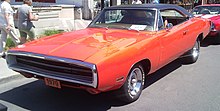
The Charger was changed slightly for the 1970 model year. This was the last year of the 2nd generation Charger and featured a large wraparound chrome bumper and the grille was no longer divided in the middle. New electric headlight doors replaced the old vacuum style. The taillights were similar to those used in 69, but 500 and R/T models came with a new more attractive taillight panel. On the R/T, new rear-facing scoops with the R/T logo were mounted on the front doors, over the door scallops. A new 440 or HEMI hood cutout made the option list for this year only. The 1970 Dodge Charger was popularized in the movie "The Fast and The Furious" as well as several other movies.
Dodge painted the hood scallop inserts black and put the silver engine callouts on top. New "High Impact" colors were given names, such as "Top Banana", and "Panther Pink". [21]
Interior changes included new high-back bucket seats, the door panels were also revised and the map pockets were now optional instead of standard. The ignition was moved from the dash to the steering column (as with all Chrysler products this year), and the glove box was now hinged at the bottom instead of the top as in 1968–69. The SE "Special Edition" trim option added luxury features and was available in the 500 SE and R/T SE versions. A new pistol grip shifter was introduced, along with a bench front seat, a first for the Charger since its debut.
A new engine option made the Charger's list for the first time, the 440 Six Pack. With three two-barrel carburetors and a rating of 390 hp (290 kW), it was one of the most exotic setups since the cross-ram Max Wedge engines of the early 1960s. The Six Pack was previously used on the mid-year 1969 Dodge Super Bee and Plymouth Road Runner. Despite this new engine, production slipped again to 46,576 mainly due to the new E-body Dodge Challenger pony car, as well as rapidly increasing automobile insurance rates. In the 1970 NASCAR season, the 1970 Charger had ten wins, more than any other car, including the 1969 Charger Daytonas and Plymouth Superbirds, thus giving Bobby Isaac the Grand National Championship. Buddy Baker, driving the blue #88 Engineering Daytona, was the first and only legal car to run over 200 mph in 1970. That record lasted for over 13 years.
Third generation
This section needs additional citations for
verification. (January 2014) |
| Third generation | |
|---|---|
 1971 Dodge Charger R/T | |
| Overview | |
| Model years | 1971–1974 |
| Assembly |
|
| Body and chassis | |
| Body style | 2-door hardtop/ coupe |
| Related | |
| Powertrain | |
| Engine | |
| Transmission | |
| Dimensions | |
| Wheelbase | 115.0 in (2,921 mm) |
| Length | 205.0 in (5,207 mm) |
| Height | 53.0 in (1,346 mm) |
1971
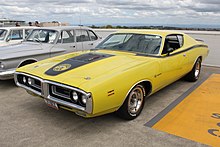
The third generation Charger made its debut for the 1971 model year, with all new "fuselage" sheetmetal and a new split grille. The interiors were like those of the E-body and were now shared by the Plymouth B-body, the Plymouth Satellite Sebring, and Road Runner. The hidden headlights were now optional. A rear spoiler and a "Ramcharger" hood were new options. This hood featured a pop-up scoop mounted above the air cleaner controlled by a vacuum switch under the dash. On Plymouth Road Runners it was called the "Air Grabber" hood, and it was previously used on the Coronet R/T and Super Bee.
Dodge also merged its Coronet and Charger lines. From 1971, all four-door B-bodies were badged as Coronets and all two-door B-bodies as Chargers. Thus for one year only, the Super Bee became part of the Charger lineup, after which it was discontinued. From 1971 to 1974, Charger models used the Coronet's VIN prefix of "W".
Several other models were carried over from 1970, including the 500, R/T, and SE. Sales of the R/T declined due in part to higher insurance costs and gasoline prices. A total of 63 Hemi RTs were built that year, marking its last appearance in any production car, and 2,659 with other engines. The 1971 model year was also the last for the 440 Six-Pack engine, which could still be mated to a 4-speed manual transmission with an optional Hurst shifter, as well as the automatic. In the Super Bee's final year, the 340 became a $44 option over the standard, low-compression 383 V8.
The "Hi-Impact" colors were discontinued after the 1971 model year; with a 1971-only "Citron Yella".
1972

The 1972 Charger introduced a new "Rallye" option to replace the R/T version. The SE was differentiated from other 1972 Chargers by a unique formal roof treatment and hidden headlights. The 383 engine was replaced with a lower compression 4-barrel 400, while the 440 engine was rated at a more realistic 280 hp (209 kW; 284 PS) net instead of the previous 350 hp (261 kW; 355 PS) gross. Beginning in 1972, all engines featured hardened valve seats to permit the use of regular leaded or unleaded gasoline rather than leaded premium fuel as in past years due to tighter emissions regulations. Though the 440+6 (designating a triple 2-barrel carb setup and 310 bhp (231 kW; 314 PS) was listed in the early 1972 sales literature, it was found in the August 1971 testing that this engine would not meet the new and more stringent 1972 emissions laws, although some early Dodge literature (August 1971 press) stated that this engine was available for 1972, and a few (six is the accepted number) factory installed six-pack Chargers were built, the engine was dropped out of production by September 1971. The optional Pistol-Grip 4-speed Hurst manual shifter could be coupled to the 340, 400, and 440 Magnum engines. The Ramcharger hood scoop was discontinued, as well as optional lower geared performance rear axle ratios and extra heavy-duty suspensions. It was also the final year for the Dana 60 differential and was available only in combination with the 440/4 speed, heavy-duty suspension, and the 3.54:1 rear axle ratio.
The only remaining "Hi-Impact" color choices were "Hemi Orange" (EV2) and "Top Banana" (FY1), the latter was available under different names through 1974.
1973


For the 1973 model year, Chargers received new sheet metal and were longer, wider, and slightly taller than the 1971-72 cars. Also new were vertically slatted taillights and new grilles. Hidden headlights were dropped, even as an option.
The 318 was still standard, with the 340 (available only on the Rallye), 360 (2-barrel only), 400 (low power 2-barrel/single exhaust and high-performance 4-barrel/dual exhaust), and 440 remaining as options.
The SE models had a new roof treatment that had a "triple opera window" surrounded by a canopy-style vinyl roof. All other models had a new quarter window treatment, discontinuing its AMC Gremlin-style window in favor of a more conventional design.
Total sales this year were around 108,000 units, the highest ever for the 1971-74 Charger generation, though more than 60 percent of the cars had non-high performance engines. The 1973 Chargers, and all Chrysler products, were equipped with 5 mph bumpers, front and rear.
1974
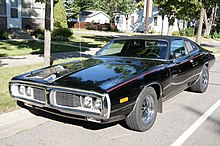
The 1974 model year saw minor changes that included new color choices, a softer grain pattern on interior surfaces, and a slight increase in the size of the rubber bumper tips. The 340 option was replaced with a 360 4-bbl as the small-block performance engine. All other engine options remained the same, including the 360 2-bbl designated by a K in the fifth symbol in the vehicle identification number. Several performance rear-end ratios, including a 3.23 "Sure Grip" rear end were available. A four-speed transmission was an option except with the 440 engine.
In spite of the Charger no longer being perceived as a performance model, sales rose as it veered towards being a personal luxury car. The muscle-car era came to a close, with 1974 as the final year for performance options.
NASCAR

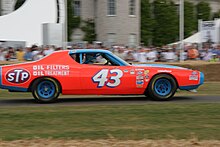
The 1971-74 Charger based cars were campaigned in NASCAR, with Buddy Baker, Bobby Isaac, Dave Marcis, and Richard Petty scoring several wins. Richard Petty won 35 races with this body style between 1972 and 1977 as NASCAR allowed the Chargers to run a few years longer than normal because Chrysler did not have a replacement car. A 1974 bodied Charger driven by Neil Bonnett scored Dodge's last NASCAR victory (until 2001) at the December 1977 Los Angeles Times 500. Richard Petty has proclaimed this body style as his favorite car that he ran during his career because it was balanced.
Fourth generation
This section needs additional citations for
verification. (January 2014) |
| Fourth generation | |
|---|---|
 1975 Dodge Charger | |
| Overview | |
| Model years | 1975–1978 |
| Assembly | United States:
Detroit,
Michigan Hamtramck, Michigan St. Louis, Missouri Canada: Windsor, Ontario |
| Body and chassis | |
| Body style | 2-door
coupe 2-door hardtop/ coupe (1976 Sport 2-door model only, also refer to the 1975 Dodge Coronet 2-door model) |
| Related |
Dodge Coronet Chrysler Cordoba Plymouth GTX Plymouth Fury |
| Powertrain | |
| Engine | 318 cu in (5.2 L)
V8 360 cu in (5.9 L) V8 400 cu in (6.6 L) V8 |
| Transmission | 3-speed
automatic 3-speed manual 4-speed manual |
| Dimensions | |
| Wheelbase | 115.0 in (2,921 mm) |
| Length | 216.0 in (5,486 mm) |
| Height | 52.0 in (1,321 mm) |
1975
The 1975 model year Charger picked up on the sales increase seen in 1974's move towards positioning it as a personal luxury car. [22] Both the Charger and the new Chrysler Cordoba sibling shared the same body based on the B platform.
The Charger SE (Special Edition) was the only model offered. It was available with the 318 cu in (5.2 L) "LA" series small block V8 and three versions of 400 cu in (6.6 L) big-block V8. The standard engine was the 360 cu in (5.9 L) 2-bbl small block. The code E58 4-bbl and dual exhaust high performance version (225 hp) were optional. [23] Sales in 1975 totaled 30,812.
Because of the extreme squareness of the body design, NASCAR teams were forced to rely on the previous years (1974) sheet metal for race-spec cars. In order for Dodge to be represented, NASCAR allowed the 1974 sheet metal to be used until January 1978, when the new Dodge Magnum was ready for race use. In 1976 a Charger was one of two NASCAR stock cars to compete in the 24hrs at LeMans, having been modified with head-lamps, tail-lamps, and windshield wipers. It was driven by Herschel and Doug McGriff and sponsored by Olympia Beer, earning the nickname "Oly Express" [24]
1976
The 1976 model year Charger range was expanded to four models; base, Charger Sport (formerly the Dodge Coronet 2-door model, which appeared for just the previous model year only), Charger SE, and the Charger Daytona. The base and Sport models used a different body than the SE and Daytona, and were essentially a re-badging of what had been the 1975 Dodge Coronet 2-door models — and available with a 225 cu in (3.7 L) Slant Six, which was not offered on the SE and Daytona. The Charger Daytona was introduced as an appearance package and was offered with either the 360 or 400 engine. Sales for 1976 increased slightly to 65,900 units.
1977
In 1977, the Charger Sport (which dated back to the former Coronet 2-door, which had appeared for only the 1975 model year only) and the base Charger were dropped as this body style became part of the newly named B-body Monaco line, and only the Charger SE and Charger Daytona were offered. Estimated production was 30,367 units. [25]
1978
The 1978 model year was a carry-over and the final use of the B-Body. A total of 2,735 Chargers were produced.
The Magnum replaced the Charger as Dodge's B-body personal luxury car and its sales increased. [26]
References
- ^ a b c Severson, Aaron (27 November 2007). "Dodging the Issue: The Original Dodge Charger". Ate Up With Motor. Retrieved 3 December 2015.
- ^ History of the American Auto. Publications International. 2004. p. 415. ISBN 978-0-7853-9874-5. Retrieved 3 December 2015.
- ^ Grist, Peter (2007). Dodge dynamite! 60 years of Dodge muscle cars. Veloce. p. 64. ISBN 978-1-84584-112-6. Retrieved 3 December 2015.
- ^ "Fish story: AMC's Marlin". Cars and Parts. 36: 20. June 1993. Retrieved 3 December 2015.
- ^ Langworth, Richard M. (2000). Complete Book of Collectible Cars: 70 Years of Blue Chip Auto Investments 1930-2000. Publications International. p. 154. ISBN 978-0-7853-4313-4. Retrieved 3 December 2015.
- ^ Bouwkamp, Burton (July 2004). "Birth and death of the original Dodge Charger: Dodge's Burt Bouwkamp speaks". Allpar.com. Retrieved 3 December 2015.
- ^ a b 1634–1699: McCusker, J. J. (1997). How Much Is That in Real Money? A Historical Price Index for Use as a Deflator of Money Values in the Economy of the United States: Addenda et Corrigenda (PDF). American Antiquarian Society. 1700–1799: McCusker, J. J. (1992). How Much Is That in Real Money? A Historical Price Index for Use as a Deflator of Money Values in the Economy of the United States (PDF). American Antiquarian Society. 1800–present: Federal Reserve Bank of Minneapolis. "Consumer Price Index (estimate) 1800–". Retrieved 29 February 2024.
- ^ Mueller, Mike (2009). The complete book of Dodge and Plymouth muscle. Motorbooks. pp. 91–92. ISBN 978-0-7603-3079-1. Retrieved 3 December 2015.
- ^ a b c Holder, William G.; Kunz, Phillip (2003). Chrysler muscle: Detroit's mightiest machines. Krause Publications. p. 42. ISBN 978-0-87349-633-9. Retrieved 3 December 2015.
- ^ a b Genat, Robert; Newhardt, David (2004). Mopar Muscle: Fifty Years. MBI Publishing. pp. 115–117. ISBN 978-0-7603-2016-7.
- ^ Mueller, Mike (2003). Musclecar Icons. MBI Publishing. p. 262. ISBN 978-0-7603-1773-0. Retrieved 3 December 2015.
- ^ "1966 Nascar Grand National Results". racing-reference.info. Retrieved 21 February 2022.
- ^ John Gunnell, Standard Catalog of American Cars 1946-1975, 4th Edition, page 353
- ^ "1967 Dodge Charger Sales". How Stuff Works. 16 October 2007. Archived from the original on 2 August 2020. Retrieved 21 February 2022.
- ^ Foster, Patrick R. (1993). American Motors, the last independent. Krause Publications. p. 111. ISBN 978-0-87341-240-7. Retrieved 3 December 2015.
- ^ Yazejian, Diran. "The '68 Charger: Nothing Copied, Copied By None - The Making of a True Icon". Retrieved 1 March 2024.
- ^ Palmer, Jamie (2 May 2019). "One Of 906! 1968 Slant-Six Dodge Charger". Barn Finds. Retrieved 7 July 2020.
- ^ Kunz, David; Bologna, Anthony; Ullrich, Scott; Kohrn, Wolfgang (21 August 2011). "1968 Bullitt Charger R/T". Ponysite.de. Retrieved 21 February 2022.
- ^ Movieclips (1 February 2017). "Bullitt (1968) - San Francisco Car Chase Scene (4/10)". YouTube. Archived from the original on 19 December 2021. Retrieved 3 April 2018.
- ^ "The Real Reason the Dodge Charger Daytona's Wing Was So Huge". Roadandtrack.com. 27 June 2016. Retrieved 28 June 2016.
- ^ "Panther Pink, one of the wildest colors to ever come out of an American automobile company". Pantherpink.com. Retrieved 3 December 2015.
-
^
"Identity Crisis: Dodge Charger". fornoob.com. 2021. Retrieved 22 February 2022.
Dodge attempted to sell the fourth generation Charger as a luxurious family coupé, unlike the Charger's predecessors.
- ^ "Dodge Charger SE 1975 4th Generation (1975-1978)". car.info.
- ^ Smit, Dylan (2016). "Helpless Hulk - 1972 Dodge "Olympia" Charger NASCAR". carmrades-blog.com.
- ^ Wilson, Gerard (16 November 2020). "Dodge Cars and Production Numbers, US". Allpar. Retrieved 21 February 2022.
- ^ Damian, Alex (6 April 2006). "1968 - 1978 Dodge Charger RT History". Top Speed. Retrieved 22 February 2022.
External links
- "Best and Worst Paint Colors". Four Wheel Drift.

